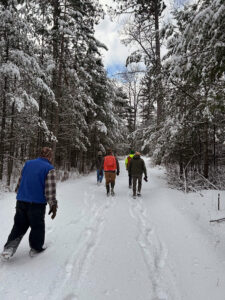By Wisconsin DNR

A snowy trek through the woods at a Vilas County audit site. / Photo Credit: Wisconsin DNR
The annual internal audit of the Wisconsin Department of Natural Resources Managed Forest Law (MFL) Certified Group took place April 7-8 with visits to 40 certified MFL properties and completed timber harvests in north central Wisconsin – specifically, in Adams, Clark, Jackson, Lincoln, Marathon, Taylor, Oneida and Vilas counties.
An internal audit is required every year for both Forest Stewardship Council® (FSC) and American Tree Farm System® (ATFS) standards, under which the MFL Certified Group is dually certified. The audit reviews a selection of MFL properties where timber harvesting was completed within the previous three years.
While it is required for forest certification, the internal audit also provides a structured opportunity to look at continuous improvement within the MFL program and the MFL Certified Group. The audit team engaged in productive discussions with field staff and landowners, witnessed a lot of good forest management and observed effective implementation of the MFL program and forest certification. The audit team also identified a handful of corrective actions to address minor forest certification issues and opportunities for improvement.
As in past audits, Best Management Practices for Water Quality (BMPs) was a common theme with findings involving wetlands, streams and forest roads and landings. BMPs are one of the key areas where forest certification requirements go above and beyond the requirements of the MFL program.
- There were two instances where landowners installed forest roads through wetlands without obtaining a DNR wetland permit. Wetlands are regulated by the Wisconsin Department of Natural Resources (DNR)’s wetlands and waterways program under state statute and administrative code. Projects in wetlands involving filling, excavating, drainage, grading, land clearing or placing structures (e.g. timber mats) typically require a permit to ensure wetland impacts are minimized. DNR water management specialists are addressing these issues.
- A small pedestrian bridge washed into a navigable stream. There were not any environmental impacts from the bridge being in the stream, but it must be removed from the stream to avoid potential future impacts. It may also come as a surprise to landowners that any crossing over a navigable waterway requires a DNR waterway crossing permit. A navigable waterway is any waterway that has a defined bed and bank, and on which it is possible to float a canoe or small watercraft on a recurring basis.
- One site had excessive rutting on trails and the log landing area due to landowner use of the forest road network. The DNR tax law forestry specialist completed post-harvest monitoring, which allowed the distinction between logging impacts and subsequent landowner activity. The landowner intends to level ruts and reinforce sensitive areas with stone.
- A finding from the 2024 internal audit where a retired skid trail on a steep grade did not have adequate water bars was not addressed at the time of the 2025 internal audit. Evidence of active, albeit relatively minor, erosion was observed on the skid trail during the 2024 internal audit. At present, however, the landowner is actively working to install additional water bars to properly retire the skid trail and minimize future erosion.
- There were three instances where water features, such as streams and ponds, impacted harvest layout and operations but were not identified on the MFL Cutting Notice. In each case, the water feature was adequately protected or not damaged during harvesting. However, the consideration of water features and on how they impact harvest layout and operations merits inclusion on the MFL Cutting Notice, and as such is an opportunity for improvement to document harvest planning with respect to BMPs.
The audit team also identified two opportunities for improvement regarding internal process and procedure for monitoring and forest certification.
- There are isolated instances where post-harvest monitoring by DNR tax law forestry specialists is being completed but is not documented.
- Related to the previously described open finding from the 2024 internal audit, corrective actions should have timely implementation. There are various resources available to assist staff and landowners to create a plan of action and various control points to ensure follow-through.
As always, the Tax Law Section is grateful to the landowners, partners and staff that actively participate in these annual audits and for their effort, diligence and willingness to go above and beyond to meet the standards of forest certification.
